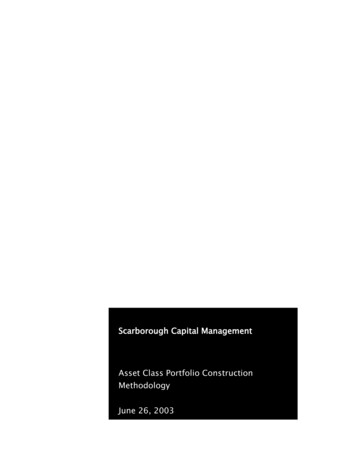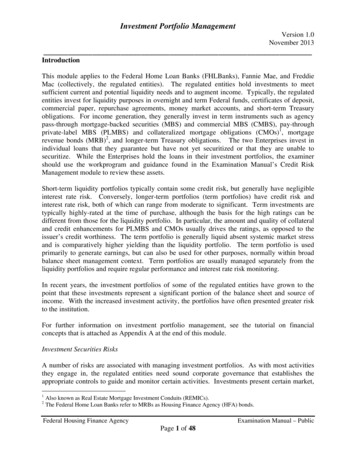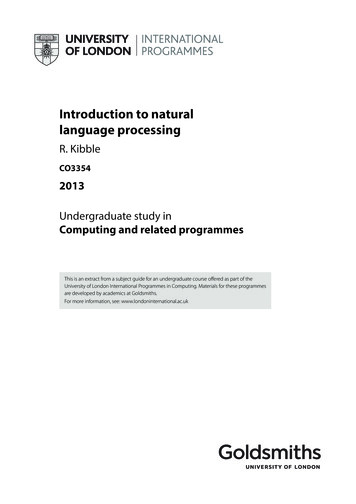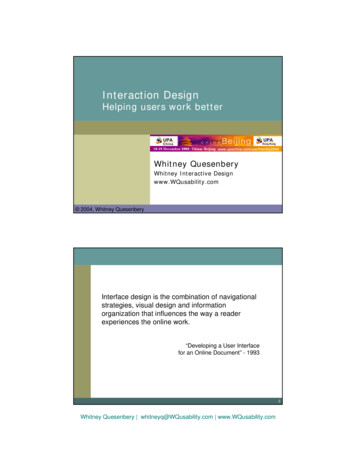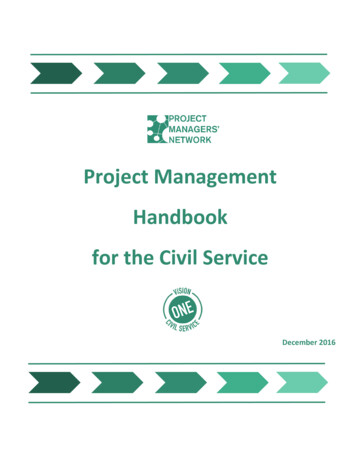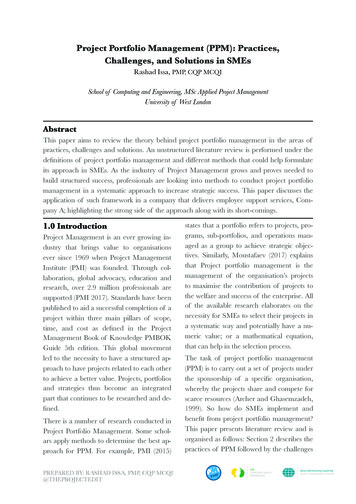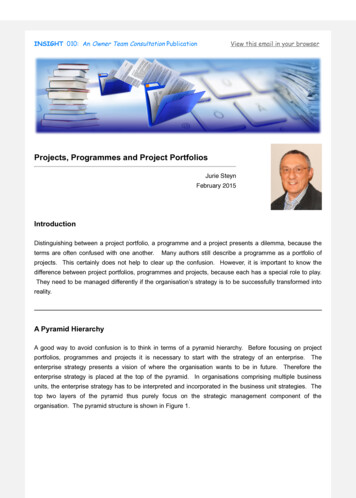
Transcription
INSIGHT 010: An Owner Team Consultation PublicationView this email in your browserProjects, Programmes and Project PortfoliosJurie SteynFebruary 2015IntroductionDistinguishing between a project portfolio, a programme and a project presents a dilemma, because theterms are often confused with one another.Many authors still describe a programme as a portfolio ofprojects. This certainly does not help to clear up the confusion. However, it is important to know thedifference between project portfolios, programmes and projects, because each has a special role to play.They need to be managed differently if the organisation’s strategy is to be successfully transformed intoreality.A Pyramid HierarchyA good way to avoid confusion is to think in terms of a pyramid hierarchy. Before focusing on projectportfolios, programmes and projects it is necessary to start with the strategy of an enterprise.Theenterprise strategy presents a vision of where the organisation wants to be in future. Therefore theenterprise strategy is placed at the top of the pyramid. In organisations comprising multiple businessunits, the enterprise strategy has to be interpreted and incorporated in the business unit strategies. Thetop two layers of the pyramid thus purely focus on the strategic management component of theorganisation. The pyramid structure is shown in Figure 1.
Figure 1: Putting project portfolios, programmes and projects in contextThe business unit strategies will give rise to strategic management plans, which in turn will generate aportfolio of programmes and / or projects to be implemented per business unit, prioritised according tobusiness objectives and needs and within the resource constraints. As you go up the pyramid from thebottom (project to programme to portfolio) then the budget, life expectancy, complexity andinterdependencies all become greater. Programmes can also reach across several or all the businessunits in the enterprise.Some DefinitionsProjects:We now need to consider the definitions of a project, a programme and a project portfolio to highlight thedifferences.Definitions from the US Project Management Institute (PMI) and the UK Office ofGovernment Commerce (OGC) will be used for this discussion.At the lowest level of the pyramid there are projects. These projects can form part of a programme, ornot. A project is:a temporary endeavour undertaken to create a unique product, service, or result (PMI, 2013a), oralternatively;a unique set of coordinated activities, with definite starting and finishing points, undertaken by anindividual or team to meet specific objectives within defined time, cost and performanceparameters as specified in the business case (OGC, 2010).Programmes:
Some projects form part of programmes, whilst others do not. This is reflected in the second level fromthe bottom of the pyramid. A programme is:a group of related projects managed in a coordinated way to obtain benefits and control notavailable from managing them individually (PMI, 2013b), or alternatively;a collection of projects that are linked together by a business need and clearly defined benefits.(OGC, 2010).Programmes thus consist of multiple projects. During the lifespan of a programme, projects can be addedto the programme or removed as the overall strategy becomes clearer.programmes is typically significantly greater than that for projects.Overall expenditure onThese efforts will also consumesignificant amounts of funding which can translate into hard choices about whether to continue ordiscontinue programmes or certain aspects of them. An example of a programme is an IT programme,designed to improve customer service, that contains an internet upgrade project, invoicing and customercomplaints projects. A programme is therefore likely to involve a number of different departments orfunctions within the organisation and can span several years.Project portfolios:Programmes and individual projects (that do not form part of programmes) roll up into portfolios as shownin the third level from the bottom of the pyramid. The correct term to use is 'project portfolio', so as not toconfuse it with financial investment portfolios. A project portfolio is:a collection of projects and / or programmes and other work that is grouped together to facilitatethe effective management of that work to meet strategic business objectives (PMI, 2013c), oralternatively;a collection of programmes or projects that define the totality of the organisation's investment inchange to facilitate strategic business objectives (OGC, 2010).The programmes and projects in an enterprise or business unit project portfolio may not be related exceptto the extent that they are identified, prioritised and authorised with a view towards achieving a set ofstrategic business objectives.For the effective management of projects and optimal use of jointresources, several projects may be grouped into sensible categories (e.g. location, business area, typesof projects) under a specific project manager.These definitions are all succinct and to the point.Although the emphasis may be slightly differentbetween the PMI and OGC definitions, the interpretation thereof is very similar. Other definitions can befound in the literature, but the ones presented here have wide support in the project environment.Enterprise-wide InitiativesThe way in which Figure 1 is presented, reflects an enterprise comprising three business units, each withits own strategic business unit objectives and project portfolios. In such a case, how will corporate orenterprise-wide initiatives or programmes be handled and should there be an enterprise project portfolio?The answer is yes, but it need not be a permanent organisation structure.Programme and projectspecialists can be seconded from other business units for the duration of the enterprise-wideprogrammes.We will consider three enterprise-wide initiatives or programmes.Each of the three enterprise
programmes consists of a number of projects as detailed in Figure 2. However, whereas enterpriseprogrammes 1 and 3 impact on all the existing business units and structures in the organisation,programme 2 does not. The focus of programme 2 is to establish a new business unit with a totally newoperating facility and product marketing department in an undeveloped area. Enterprise programmes thusdo not only impact existing business units, but may actually establish new business units for organisationgrowth.Figure 2: Enterprise-wide project portfolios and programmesThree examples of enterprise-wide initiatives or programmes are given in Figure 2, namely the roll-out ofnew business management software to the entire organisation; the establishment of a new manufacturingcompany, and; the roll-out of a business ethics initiative for the organisation.An enterprise projectportfolio is also shown for managing, coordinating and prioritising enterprise-wide programmes.Closing RemarksIt is essential for anyone involved in projects and those in senior management positions to have a clearunderstanding of the terminology used in project portfolio management. Hopefully this brief overview ofprojects, programmes and project portfolios will help to firmly establish the concepts.ReferencesOGC (Office of Government Commerce), 2010, The portfolio, programme and project managementmaturity model (P3M3), 2nd edition., Axelos Limited, Norwich, UK.
PMI (Project Management Institute), 2013a, A guide to the project management body of knowledge(PMBOK Guide), 5th edition., Project Management Institute, Inc., Newtown Square, Pennsylvania.PMI (Project Management Institute), 2013b, The standard for program management, 3rd edition., ProjectManagement Institute, Inc., Newtown Square, Pennsylvania.PMI (Project Management Institute), 2013c, The standard for portfolio management, 3rd edition., ProjectManagement Institute, Inc., Newtown Square, Pennsylvania.Look out for the March Insight Article where the future of GTL and CTLprojects is considered in the light of the current low oil price.ShareFacebook PageForwardOur WebsiteCopyright 2015 Owner Team Consultation, All rights reserved.Our mailing address is:info@ownerteamconsult.comunsubscribe from this listupdate subscription preferencesShareEmailLinkedIn
We now need to consider the definitions of a project, a programme and a project portfolio to highlight the differences. Definitions from the US Project Management Institute (PMI) and the UK Office of Government Commerce (OGC) will be used for this discussio
